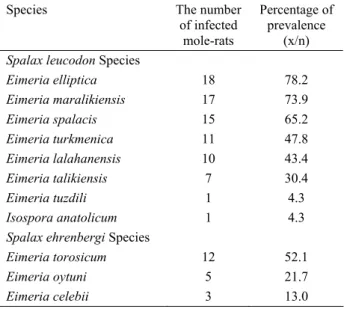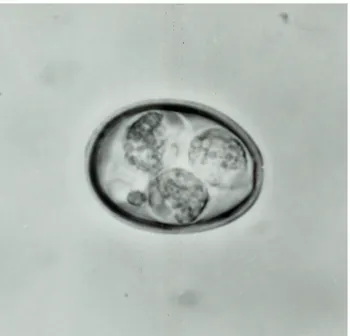Ankara Üniv Vet Fak Derg, 57, 209-212, 2010
Short Communication / Kısa Bilimsel Çalışma
The coccidian parasites (Eimeridae) of Spalax leucodon Nordmann
(Mole-Rat)
Serpil NALBANTOĞLU1, Hüseyin TÜRKER2, Zafer KARAER1
1 Department of Parasitology, Faculty of Veterinary Medicine, University of Ankara, 06110 Ankara, Turkey; 2Ministry of National
Education General Directorate for Higher Education, 06500 Ankara, Turkey.
Summary: Twenty-three mole-rats of the Spalax leucodon Nordmann superspecies were collected from Eryaman district of
Ankara in Turkey. Faeces samples were examined for coccidian oocysts and the 23 examined animals (100%) were determined to be infected with 2-8 species representing 10 species of eimerians and 1 species of isosporan. The prevalence of coccidian in the population of herbivorous mole-rats sampled is reported as 78.2% Eimeria elliptica, 73.9% E.maralikiensis, 65.2% E.spalacis, 52.1% E.torosicum, 47.8% E.turkmenica, 43.4% E.lalahanensis, 30.4% E.talikiensis, 21.7% E.oytuni, 13% E.celebii, 4.3% E.tuzdili, 4.3% Isospora anatolicum. As a result, E.lalahanensis, E.tuzdili, E.spalacis, E.elliptica, E.turkmenica, I.anatolicum, as well as
E.maralikiensis, E.talikiensis, E.oytuni, E.celebii, E.torosicum were determined in S.leucodon in Turkey. In addition, E.maralikiensis
and E.talikiensis were reported from S.leucodon for the first time in Turkey. Furthermore the species which were found in
S.ehrenbergi such as E.oytuni, E.celebii, E.torosicum were also reported from S.leucodon for the first time in this study.
Key words: Eimeria, Isospora, mole-rats (Spalax leucodon).
Spalax leucodon Nordmann türü kör farelerde coccidian (Eimeridae) parazitler
Özet: Bu çalışma, Ankara’nın Eryaman yöresinden yakalanan 23 Spalax leucodon türü kör farede coccidian oocystlerinin
tespiti amacıyla yapılmıştır. Muayene edilen 23 kör farenin tamamı (%100) 2-8 türle, 10 farklı Eimeria ve 1 İsospora oocysti ile enfekte bulunmuştur. Kör farelerden elde edilen dışkı örneklerinde %78.2 Eimeria elliptica, %73.9 E.maralikiensis, %65.2
E.spalacis, %52.1 E.torosicum, %47.8 E.turkmenica, %43.4 E.lalahanensis, %30.4 E.talikiensis, %21.7 E.oytuni, %13 E.celebii,
%4.3 E.tuzdili, %4.3 Isospora anatolicum rapor edilmiştir. Sonuç olarak S.leucodon’da daha önce Türkiye’den bildirilen
E.lalahanensis, E.tuzdili, E.spalacis, E.elliptica, E.turkmenica ve I.anatolicum türleri ile ülkemizde henüz bildirilmemiş olan E.maralikiensis ve E.talikiensis türleride bulunmuştur. Ayrıca yine bu çalışmada S.ehrenbergi’de bulunan E.oytuni, E.celebii, E.torosicum türleri S.leucodon’da ilk defa tespit edilmiştir.
Anahtar sözcükler: Eimeria, Isospora, kör fare (Spalax leucodon).
In 5 previous articles 19 new species of Eimeria and 2 new species of Isospora have been described in herbivorous mole-rats, Spalax leucodon Nordmann and
Spalax ehrenbergi Nehring of the family Spalacidae. Eimeria maralikiensis, E.talikiensis, E.leucodonica and E.lalahanensis, E.tuzdili, E.spalacis, E.elliptica, E.turkmenica and Isospora anatolicum were first reported
from herbivorous mole-rats of S.leucodon (4, 5). Eimeria
urfensis, E.adiyamanensis, E.haranica, E.marasensis, E.oytuni, E.celebii, E.torosicum, E.microspalacis, E.spalacensis, E.anzanensis, E.carmelensis and Isospora spalacensis were first described from herbivorous
mole-rats of S.ehrenbergi (1-3). Eimeria tuzdili, E.spalacis,
E.elliptica, E.turkmenica and I. anatolicum species have
been revealed from herbivorous mole-rats of S.ehrenbergi (1-3).
This study was aimed to investigate the coccidian parasites of Spalax leucodon Nordmann (mole-rat) in Eryaman district of Ankara in Turkey.
Twenty-three herbivorous mole-rats, Spalax leucodon Nordmann, trapped from Eryaman district of Ankara in Turkey were examined for coccidian parasites. Faecal samples were placed separately to form a thin layer in petri dishes containing 2.5% (w/v) potassium dichromate (K2Cr2O7), mixed thoroughly, and kept at 20-22°C to
allow the oocysts to sporulate. The oocysts were examined periodically to determine sporulation. Oocysts were stored, measured in detail as described by Sayin et al. (4). The prevalence of coccidian in the population of herbivorous mole-rats sampled is also reported.
All coccidian oocysts were distinguished on structural basis [Such as: note characteristic features including the
Serpil Nalbantoğlu - Hüseyin Türker - Zafer Karaer 210
oocysts shape, size, Length/Width ratios, the oocysts wall layer (number of layers, outer and inner character, size and colour), note presence/absence of the micropyle, micropyle cap, polar granules, oocyst residuum; note characteristic features including the sporocysts shape, size, stieda body; residual body, granules; sporozoites shape and refractile body]. Oocysts were concentrated by flotation in Sheather's sugar solution and examined with an Olympus microscope under 1000x and 400x magnification. At least 25-50 oocysts (or found in) were measured with an ocular micrometer.
All the 23 herbivorous mole-rats examined were infected with coccidian oocysts (100%). Ten species of
Eimeria and 1 species Isospora were found in these
animals (Table 1). The coccidian species identified and the prevalence of these species in the population of the herbivorous mole-rats examined are indicated in Table 1. The prevalence in the population of herbivorous mole-rats sampled is reported as 78.2% E.elliptica, 73.9% E.
maralikiensis (Figure 1), 65.2% E.spalacis, 47.8% E.turkmenica, 43.4% E.lalahanensis, 30.4% E.talikiensis
(Figure 2), 4.3% Etuzdili, 4.3% I.anatolicum, 52.1%
E.torosicum (Figure 3), 21.7% E.oytuni (Figure 4), 13% E.celebii (Figure 5). As also understood from Table 1, E.elliptica, E.maralikiensis, E.spalacis and E.torosicum
are the species which occurred most frequently in the 23 animals examined.
Table 1. The prevalence of coccidian parasites (Spalax
leucodon and Spalax ehrenbergi species) in 23 herbivorous
mole-rats (Spalax leucodon) fecal specimens
Tablo 1. Dışkı örneği toplanan 23 kör faredeki coccidian parazit (Spalax leucodon and Spalax ehrenbergi türleri) prevalansı
Species The number
of infected mole-rats
Percentage of prevalence
(x/n)
Spalax leucodon Species
Eimeria elliptica 18 78.2 Eimeria maralikiensis 17 73.9 Eimeria spalacis 15 65.2 Eimeria turkmenica 11 47.8 Eimeria lalahanensis 10 43.4 Eimeria talikiensis 7 30.4 Eimeria tuzdili 1 4.3 Isospora anatolicum 1 4.3
Spalax ehrenbergi Species
Eimeria torosicum 12 52.1
Eimeria oytuni 5 21.7
Eimeria celebii 3 13.0
x: The number of infected mole-rats n: Total number of mole-rats (n:23)
Twenty-three examined animals (100%) were infected with 2-8 species representing 10 species of
eimerians and 1 species of isosporan (Table 2). In Table 2, an analysis of the prevalence of different species is given, indicating that multiple species were common, but these most frequently consisted of 5 species. One species was not observed in mole-rats.
Table 2. The number of species of coccidan parasites occurring in individual herbivorous mole-rats fecal specimens
Tablo 2. Kör farelerdeki dışkı örneklerinde coccidian parazit türü sayısı
The number of species present in specimens
2 3 4 5 6 7 8 The number of infected
mole-rats
3 4 3 8 3 1 1 Percentage of specimens
(x/n)
13 17.3 13 34.7 13 4.3 4.3 x: The number of infected mole-rats
n: Total number of mole-rats (n:23)
Earlier, 8 eimerian and 1 isosporan species were described from S.leucodon, and 15 eimerian and 2 isosporan species were described from S.ehrenbergi: Veisov (5) described 3 new eimerian species from 14
S.leucodon in U.S.S.R.; Sayin et al. (4) described 5 new
eimerian species, and 1 new isosporan species from 96
S.leucodon trapped in Turkey; Sayin (3) described 7 new
eimerian species and 4 new eimerian host species from 41 S.ehrenbergi, also from Turkey; Golemansky and Darwish (2) described 1 new eimerian species and 1 new host isosporan from 29 S.ehrenbergi collected in Syria. Couch et al. (1) described 3 new eimerian species and 1 new isosporan species from 45 S.ehrenbergi in Israel.
Recently, only two articles have been published on the coccidian of herbivorous mole-rats of S.leucodon Nordmann. Eight new species of Eimeria and 1 new species of Isospora were described by Veisov (5) and Sayin et al. (4), their prevalence were E.maralikiensis (35.7%), E.talikiensis (14.2%), E.leucodonica (7.1%);
E.lalahanensis (10.4%), E.tuzdili (3.1%), E.spalacis
(93.7%), E.elliptica (8.4%), E.turkmenica (1.1%). Prevalence was determined as 73.9% E.maralikiensis, 30.4% E. talikiensis, 43.4% E.lalahanensis, 4.3%
E.tuzdili, 65.2% E.spalacis, 78.2% E.elliptica, 47.8% E.turkmenica as well as 4.3% I.anatolicum in this study.
Excluding E.elliptica, the prevalence of these coccidians were determined to be higher than previous reports (4, 5).
Eimeria leucodonica was not found in the 23 herbivorous
mole-rats examined in this study.
Eimeria oytuni (4%), E.celebii (2%), E.torosicum
(4%) were first found in Turkey by Sayin (3) from herbivorous mole-rats of S.ehrenbergi Nehring. In this study, E.oytuni (21.7%), E.celebii (13%), E.torosicum (52.1%) have also been reported for the first time from herbivorous mole-rats of S.leucodon Nordmann. The
Ankara Üniv Vet Fak Derg, 57, 2010 211
prevalence of these Eimeria species were higher in the original host S.ehrenbergi as compared to the earlier report. However, these species resembled the original host species in the morphological and basic structural features of oocysts. Similar to the species which were determined in herbivorous mole-rats of S.leucodon Nordmann such as E.tuzdili (3), E.spalacis (2, 3),
E.elliptica (1, 3), E.turkmenica (3) and I.anatolicum (2)
were reported in herbivorous mole-rats of S. ehrenbergi Nehring. In previous studies, certain coccidian parasites were common in both S.leucodon and S.ehrenbergi. It is not surprising that E.oytuni, E.celebii, E.torosicum may be common in both hosts.
Figure 1. Eimeria maralikiensis Şekil 1. Eimeria maralikiensis
Figure 2. Eimeria talikiensis Şekil 2. Eimeria talikiensis
Figure 3. Eimeria torosicum Şekil 3. Eimeria torosicum
Figure 4. Eimeria oytuni Şekil 4. Eimeria oytuni
Figure 5. Eimeria celebii Şekil 5. Eimeria celebii
Serpil Nalbantoğlu - Hüseyin Türker - Zafer Karaer 212
As a result, E.lalahanensis, E.tuzdili, E.spalacis,
E.elliptica, E.turkmenica, I.anatolicum, as well as E.maralikiensis, E.talikiensis, E.oytuni, E.celebii, E.torosicum were determined in S.leucodon in Turkey. In
addition, E.maralikiensis and E.talikiensis were reported from S.leucodon for the first time in Turkey. Furthermore the species which were found in S.ehrenbergi such as
E.oytuni, E.celebii, E.torosicum were also reported from S.leucodon for the first time in this study.
Acknowledgement
We wish to thank Prof. Dr. Fahri Sayin for his assistance in oocyst identification.
References
1. Couch L, Duszynski DW, Nevo E (1993): Coccidia
(Apicomplexa), genetic diversity, and enviromental unpredictability of four chromosomal species of the subterranean superspecies Spalax ehrenbergi (mole-rat) in Israel. J Parasitol, 79, 181-189.
2. Golemansky VG, Darwish AI (1992): The coccidian
parasites (Apicomplexa, Coccidia) of the herbivorous mole-rat Spalax (Microspalax) ehrenbergi. Acta
Protozool, 31, 173-176.
3. Sayın F (1980): Eimeriidae of the herbivorous mole-rats,
Spalax ehrenbergi Nehring. J Protozool, 27, 364-367.
4. Sayın F, Dinçer Ş, Meriç M (1977): Coccidia (Protozoa:
Eimeridae) of the herbivorous mole-rats, Spalax leucodon Normdan. J Protozool, 24, 210-212.
5. Veisov A (1975): Tri novyky vida koktsidii roda Eimeria is gornogo ili belozobugo slepysha Spalax leucodon Nordman (1840) [Three new species of coccidia of the genus Eimeria from Spalax leucodon Nordman (1840).]. Izvest Akad Nauk Azerbaid. SSR, Ser Biol Nauk, 4, 82-84.
Geliş tarihi: 03.06.2009 / Kabul tarihi: 07.09.2009
Address for correspondance
Serpil Nalbantoglu, DVM, PhD Associate Professor
Department of Parasitology Faculty of Veterinary Medicine
University of Ankara, 06110, Ankara, Turkey E-mail: nalbanto@veterinary.ankara.edu.tr

